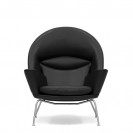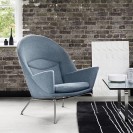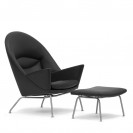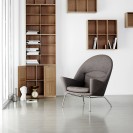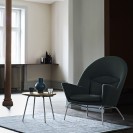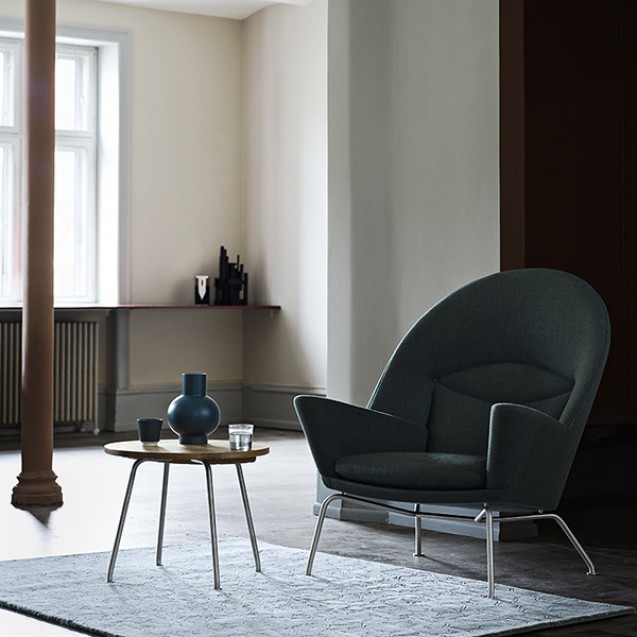CH468 OCULUS CHAIR
The story of Hans J.
Wegner’s CH468 Oculus Chair is quite unique. In examining the vast archives of
the Hans J. Wegner Studio, Carl Hansen & Søn came across a clay model of an
unknown lounge chair, along with photos of an early prototype. A later
discovery of Wegner’s drawings of the chair made it possible to start
production in 2010 in line with the designer’s original vision.
“Oculus”, Latin for eye,
refers to the eye-like shape in the upholstery of the chair’s back. The
combination of an unusual design with a supremely comfortable, supportive
structure made the Oculus Chair an instant favorite.
The chair’s curved,
over-sized backrest and large, sloping armrests create an inviting nook for
relaxation and provide a dramatic contrast to the lightweight stainless steel
legs. The bold shape can serve as the centerpiece of any room on its own, and
functions well in groups.
The CH468 Oculus Chair is available
with the matching CH446 footstool for added comfort.
| About Designer | |
|---|---|
Hans J. Wegner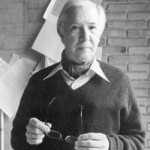 |
As
a driving force behind 'Danish Modern', Hans J. Wegner helped change the
general public's view of furniture in the 1950s and 1960s. His passion for
designing chairs, more than 500 of them, is recognized worldwide and reflected
in his title 'the Master of the Chair'. He is famous for integrating perfectly
executed joints with exquisite shapes and combining them with a constant
curiosity for materials and deep respect for wood and its natural
characteristics. His designs furnish minimalism with organic and natural
softness. Hans
J. Wegner was born in 1914 in Tønder in Southern Denmark, the son of a
shoemaker. At the age of 17, he completed his apprenticeship as a cabinetmaker
in the workshop of H. F. Stahlberg where his first designs saw the light of
day. At the age of twenty he moved to Copenhagen, Denmark, to attend the School
of Arts and Crafts, where he studied from 1936-1938 before embarking on a
career as an architect. In
1940, Wegner joined Arne Jacobsen and Erik Møller and began designing furniture
for the new City Hall in Aarhus, Denmark's second-largest city. This was also
the year when Wegner began working with master cabinetmaker Johannes Hansen,
who played a major role in introducing modern design to the Danish public. Hans
J. Wegner opened his own drawing office in 1943. In 1944, he designed the first
China Chair in a series inspired by Chinese chairs from the Ming dynasty. One
of these chairs, the Wishbone Chair, designed in 1949 and produced by Carl
Hansen & Søn since 1950, went on to become Wegner's most successful design
of all time. Hans
J. Wegner is considered one of the most creative and productive Danish
furniture designers of all time. He has received several accolades given to
designers, including the Lunning Prize in 1951 and The 8th International Design
Award in 1997. He
became an honorary member of the Royal Danish Academy for the Fine Arts in
1995, and an honorary doctor of the Royal College of Art in 1997. Almost all of
the world's major design museums, from The Museum of Modern Art in New York to
Die Neue Sammlung in Munich, feature his furniture in their collections. Hans
J. Wegner died in Denmark in January 2007 - at the age of 92.
Carl
Hansen & Søn's alliance with Hans J. Wegner began in 1949 and resulted in
the production of a wide range of Wegner designs spanning dining chairs, easy
chairs, footrests, sofas and coffee tables, dining tables as well as high-end
office furniture and children's furniture. Wegner's iconic designs from Carl
Hansen & Son include the Shell Chair, Wing Chair and Wishbone Chair. |




